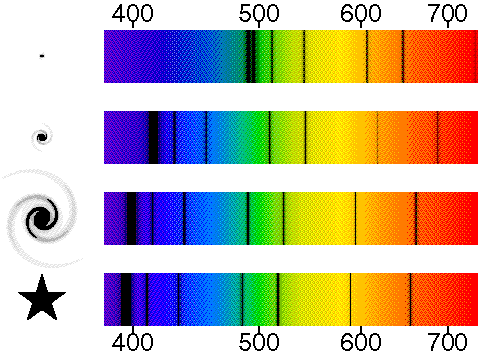| Doppler effect
The difference between the frequency of a wave (as of sound or light) as measured at its source and as measured by an observer in relative motion. The Doppler effect can be used to determine the relative speed of an object by bouncing a wave (usually a radar wave) off the object and measuring the shift in the frequency of the wave. This technique is the basis of Doppler radar, as used in traffic control and navigation systems. The Doppler effect is also known as the Doppler shift.
 If the source and the observer are getting farther apart, the observed frequency is lower than the source frequency. In the case of light waves, the phenomenon is known as red shift. The amount of red shift in the spectra of stars is used in astronomy to determine how quickly the Earth and those stars are moving apart. If the source and the observer are getting farther apart, the observed frequency is lower than the source frequency. In the case of light waves, the phenomenon is known as red shift. The amount of red shift in the spectra of stars is used in astronomy to determine how quickly the Earth and those stars are moving apart.  If the source and the observer are getting closer together, the observed frequency is higher than the source frequency. In the case of light waves, the phenomenon is known as blue shift. If the source and the observer are getting closer together, the observed frequency is higher than the source frequency. In the case of light waves, the phenomenon is known as blue shift.
A Closer Look The whistle of an approaching train has a higher pitch as the train approaches than when it recedes, even though that same whistle, heard by a passenger on the train, maintains a constant pitch. This is an example of the Doppler effect, common to all wave phenomena (in this case, a sound wave). Motion toward the source of a wave (or, equivalently, motion of the source toward the observer) entails that the peaks and troughs of the wave are encountered more quickly than if there were no motion, so the frequency of the wave is higher for the moving observer (hence the higher whistle pitch). Similarly, motion away from the source entails following the wave's motion, so the peaks and troughs are encountered less often, and the frequency is lower for the moving observer (hence the lower whistle pitch). The Doppler effect on light waves has enabled scientists to determine that the universe is expanding. The frequencies of light given off by various substances (such as the burning of hydrogen in the fusion reactions of most stars) has been found to be lower in distant galaxies and other celestial objects, a phenomenon called red shift, since the visible light is shifted toward the red, low-frequency end of the spectrum. Astronomer Edwin Hubble reasoned that the red shift was due to the Doppler effect. As galaxies speed away from us, the frequency of the light emitted appears lower. Doppler radar and sonar use the Doppler effect on reflected radio and sound waves to distinguish between stationary and moving objects and to determine the velocity of moving ones; theecholocation of bats and some whales also exploits the Doppler effect on reflected sound waves for navigating and catching prey.
|
The schematic diagram below shows a galactic star at the bottom left with its spectrum on the bottom right. The spectrum shows the dark absorption lines first seen by Fraunhofer. These lines can be used to identify the chemical elements in distant stars, but they also tell us the radial velocity. The other three spectra and pictures from bottom to top show a nearby galaxy, a medium distance galaxy, and a distant galaxy. The pictures on the left are negatives, of course, so the brightest parts of the galaxies are black. Notice how the pattern of absorption lines shifts to the red as the galaxies get fainter. The numbers above and below the spectra are the measured wavelengths in nm [nanometers].

Doppler effect images
Doppler effect
As a motorcycle speeds forward, the frequency (and pitch) of the sound waves in front of the motorcycle become higher, and the frequency (and pitch) of the sound waves behind it become lower.

Doppler shift
The change in position of spectral lines due to the Doppler effect; named after Christian Doppler. If an object is approaching, its light is compressed and any lines in its spectrum appear at shorter wavelengths than if the object were at rest (see blue shift). If the object is receding, the opposite effect occurs and the spectral lines are shifted toward the longer wavelength or red end of the spectrum (see red shift).
TYPES OF DOPPLER:
• Color Doppler uses a computer to convert
Doppler measurements into an array of colors
to visualize the speed and direction of blood
flow through a blood vessel.
• Power Doppler is a newer technique that is
more sensitive than color Doppler and capable
of providing greater detail of blood flow,
especially when blood flow is little or
minimal. Power Doppler, however, does not
help the radiologist determine the direction
of blood flow, which may be important in
some situations.
• Spectral Doppler. Instead of displaying
Doppler measurements visually, Spectral
Doppler displays blood flow measurements
graphically, in terms of the distance traveled
per unit of time.
H
|




